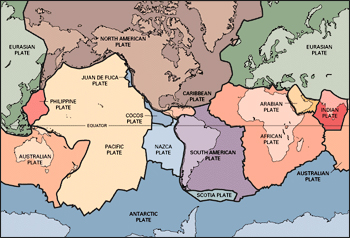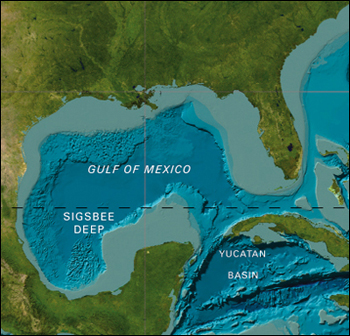

Definitions
Types of continental margins - active and passive
A continental margin is the edge of a continent.
What makes a continent a "continent"?
Geologically speaking, a continent is a continuous piece of crust composed on "continental" rocks — rocks such as diorite, andesite, granite, rhyolite, etc.
Continents make up one of the two types of crust that occur on Earth — oceanic and continental crusts. Continental crust is thicker than oceanic crust.

 A "continental" margin isn't the same thing as a "plate" margin. Look at the eastern edge of North America. Is it located in the same place as the eastern edge of the North American tectonic plate? How about the western edge of North America?
A "continental" margin isn't the same thing as a "plate" margin. Look at the eastern edge of North America. Is it located in the same place as the eastern edge of the North American tectonic plate? How about the western edge of North America?
A continental margin is the edge of a continent: A plate margin is the edge of a plate. Continents and plates are not the same thing. Continental margins are relevant because many people live near coasts. Plate margins are relevant becuase that's where plate interact.
Image source - USGS

 The edge of most continents extends beyond the coast. Look at Florida. Shallow marine areas less than 200 m below sea level extend far beyond the coast of the Florida peninsula.
The edge of most continents extends beyond the coast. Look at Florida. Shallow marine areas less than 200 m below sea level extend far beyond the coast of the Florida peninsula.
 Zoom
Zoom
Image source - GEBCO
 Seafloor less than 200 mbsl (meters below sea level
Seafloor less than 200 mbsl (meters below sea level
 Seafloor greater than 200 mbsl (meters below sea level
Seafloor greater than 200 mbsl (meters below sea level
Two kinds of continental margins
Questions for thought
A continental margin is the edge of a continent.
What makes a continent a "continent"?
Geologically speaking, a continent is a continuous piece of crust composed on "continental" rocks — rocks such as diorite, andesite, granite, rhyolite, etc.
Continents make up one of the two types of crust that occur on Earth — oceanic and continental crusts. Continental crust is thicker than oceanic crust.

A continental margin is the edge of a continent: A plate margin is the edge of a plate. Continents and plates are not the same thing. Continental margins are relevant because many people live near coasts. Plate margins are relevant becuase that's where plate interact.
Image source - USGS

Image source - GEBCO
Two kinds of continental margins
- Active margins
- Cases of continental margins that are on or very close to a plate margin. Most continental margins around the Pacific are active. Key characteristics of active continental margins include the activity of volcanoes and earthquakes, narrow continental shelves, large coastal mountains, and much more.
- Passive margins
- Cased of continental margins that are well within the interiors of a plate and far away from plate margins. Most continental margins around the Atlantic are passive. Key characteristics of passive continental margins includes the absence of volcanoes and much earthquake activity, wide continental shelves, no large coastal mountains, and much more.

Image source - USGS
Questions for thought
- What kind of continental margin is - the eastern edge of North America? - the western edge of North America?
- How wide is the continental shelf on - the eastern edge of North America? - the western edge of North America?
- Which kind of continental margin tends to have wider continental shelves, active or divergent?
- Which kind of continental margin tends to rimmed with large mountain ranges?
- Which kind of continental margin tends to associated with the places where the world's largest rivers meet the oceans?
- Which kind of margin experiences greater earthquakes and volcanism?
- Where is the westernmost edge of the continent of North America near San Diego?
- Is San Diego near a passive or active continental margin?